PIONEERING IN PAPUA NEW GUINEA

Derek Edward Smith
This is to reminisce my pioneering in Papua New Guinea from 1983 to 2020. Occasionally I have thought it might be of some use to record memories of my years of pioneering in Papua New Guinea. Certainly, I have been urged to do so by friends such as Bahá’í historian Graham Hassall, but I have never set this task as a priority, considering the demands of the latest ‘Plan’ of the Universal House of Justice, together with the competing demands of family and profession as taking priority. Perhaps a truer explanation is to quote an expression used by the beloved Guardian, ‘the natural inertia’ that affects us all – more simply described as sheer laziness. However, some spare time created by ‘medical leave’ in 2018 had pushed me to sit on the keyboard and make such an attempt.
And since starting to record these memories, circumstances which I will explain later, have persuaded Tulua (my wife) and I to leave Papua New Guinea and so it is 12 September 2020 and I am sitting in Covid-19 quarantine in room 510 of the rather salubrious Sebel Hotel in Manukau City to try to add some more words to this record.
MY PARENTS SET ME UP FOR BAHÁ’Í PIONEERING
Basil Smith
My dad Basil Smith had run away from England after the Second World War, visiting New Zealand for a youthful adventure after serving as a Major in the British Army Veterinary Corps. He disliked the stratified society of Britain and revelled in the free atmosphere of New Zealand. I remember that his photo album was full of deer hunting exploits. He was proud of his German camera with which had taken those photos. He remained a keen photographer, always having his camera ready to record some aspect or event in the life of his expanding family.
He had been brought up in Ulverston, a small town in the north of England by a strict Catholic father Edward Smith, and though he had somewhat lost his own faith in his youth, he later felt it would be good to bring up his children with some religious convictions. He said he hated being forced to attend mass twice on Sundays at his father Edward’s insistence.
I visited Ulverston once with my son Zafar on our pilgrimage trip to celebrate his graduation from medical school in about 2008. We saw the respectable two-story townhouse on the edge of the town where my father had been raised by his parents Edward and Mary (my granny). I sadly never learned much about them, but my middle name is Edward, as Edward senior died about the time I was born. As children, we asked our father if we could phone up granny in England, but he said that the excitement might kill her! So my memory of her is a photo somewhere in the family albums, a slim rather frail-looking lady in her late middle age. Her maiden name was Williamson, and recently we have found out about adventurers from her family – one a seafarer who settled in France where we have distant cousins who have visited New Zealand and one even visited Papua New Guinea. Another Williamson was Hajii Williamson who has a book written of his Middle Eastern adventures and of his conversion to Islam!
Percy Hill was one of the 18 children of John Hill, an impoverished farmer on the inhospitable and infertile moors of Devonshire. My mum Shirley and I drove down to Devon just before our pilgrimage in 1976 to see the Hill family farm at Knowstone Village that had been lost to loan sharks just before the First World War. When the farm was lost, Percy and his siblings had to scatter to the ‘colonies’ which has given me second or third cousins in Australia, Canada, South Africa, and New Zealand. Interesting that the woman owning the farm who we met in 1976 was the wife of ‘The Man of The Trees’- St. Barbe Baker who was a famous Bahá’í conservationist. The farmhouse was a ‘bush materials’ construction with earth floor, stone walls, and a thatched roof. I remember that there was a huge rustic open fireplace and chimney in the middle of the house. Percy first went to Bristol to seek his fortune, worked in a draper’s shop, and met Irene Crump from a well-off Bristol family.
The two were married and set off ‘pioneering’ to New Zealand perhaps just before World War I. I know ‘Abdu’l-Bahá (Master) visited Bristol about this time and imagine that His spiritual influence was mysteriously vibrating when my mother Shirley was born in 1921. My mother and I visited Bristol in 1976 and there met my great aunty ‘Billy Crump’, then in her 90’s. She saw the English winter was drying out my skin and insisted on buying some skin cream for me! Irene’s brother Dudley was an artistic ‘Vaudeville performer’ who could sing and dance and I fondly remember meeting ‘Uncle Dudley’ in his old aged in Dargaville. His son Hector Crump settled at Okaihau in Northland and I remember staying with Hector and his twin sons who were a bit older than me and took me on adventures around their little farm in the late 1960s.
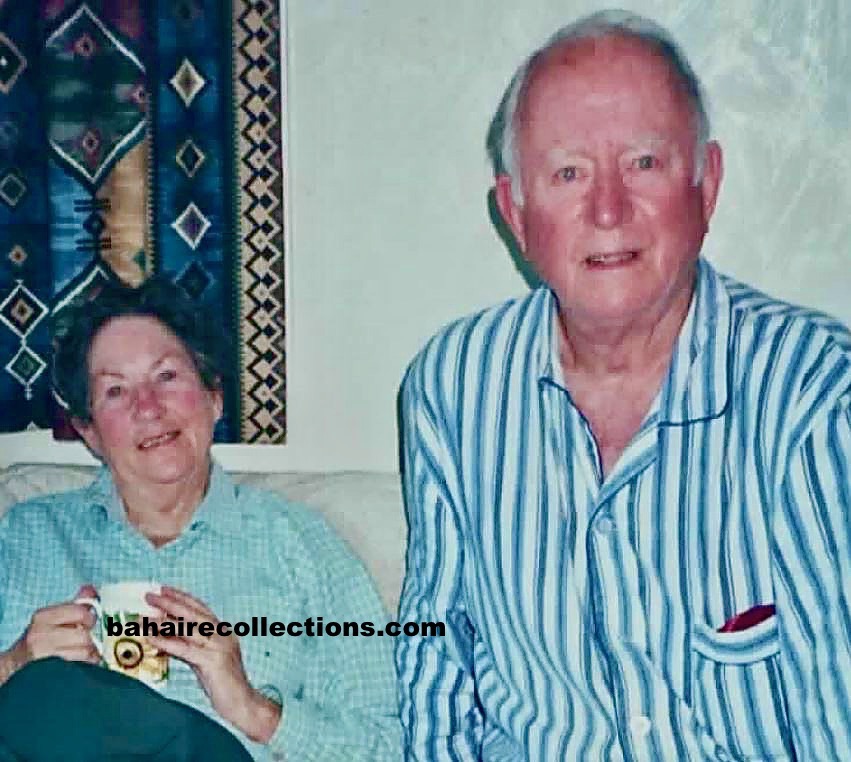
My parents – Shirley and Basil
So, dad had a history of burning bridges and enjoying the adventure of pioneering life.
Dad didn’t talk much about the war though when I was going to Rome for a brief work assignment, he mentioned he had been stationed in an army base just outside Rome probably in 1944. His job was to look after the health of the pack mules that were needed to transport war supplies into the alps to allow the British Army to chase the Nazis. Dad did mention with a smile that he had two war wounds on his brow – one from crashing a jeep returning from a drunken party and the other from the kick of a nasty stubborn mule. Another head scar was from the rugby field and apparently, dad was a top try-scorer for his University of Liverpool rugby team about 1939. Dad told Craig that during the war he would keep his revolver under his pillow but only once was shot at by the enemy while driving a vehicle. My mother’s brothers Derek and Norman had real wounds from shrapnel in the fight against Rommel in North Africa.
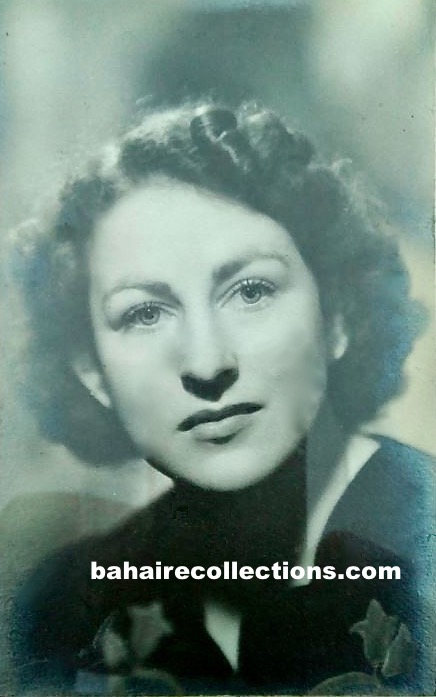
Shirley Doris Smith (nee Hill) about 1940
My mother Shirley was brought up as a farm girl near Dargaville. Her parents Percy and Irene Hill- themselves refugees from the poverty of rural life of the Devonshire moors of southern England had headed to New Zealand just before the First World War. In fact, Irene was from an upper-middle-class family from Bristol and must have been living there when the Master visited England in 1912-13.
Percy was a progressive farmer and with a keen intellect and world-view. He loved to debate politics and after retiring from the farm served on the Dargaville Town Council and the Electric Power Board.
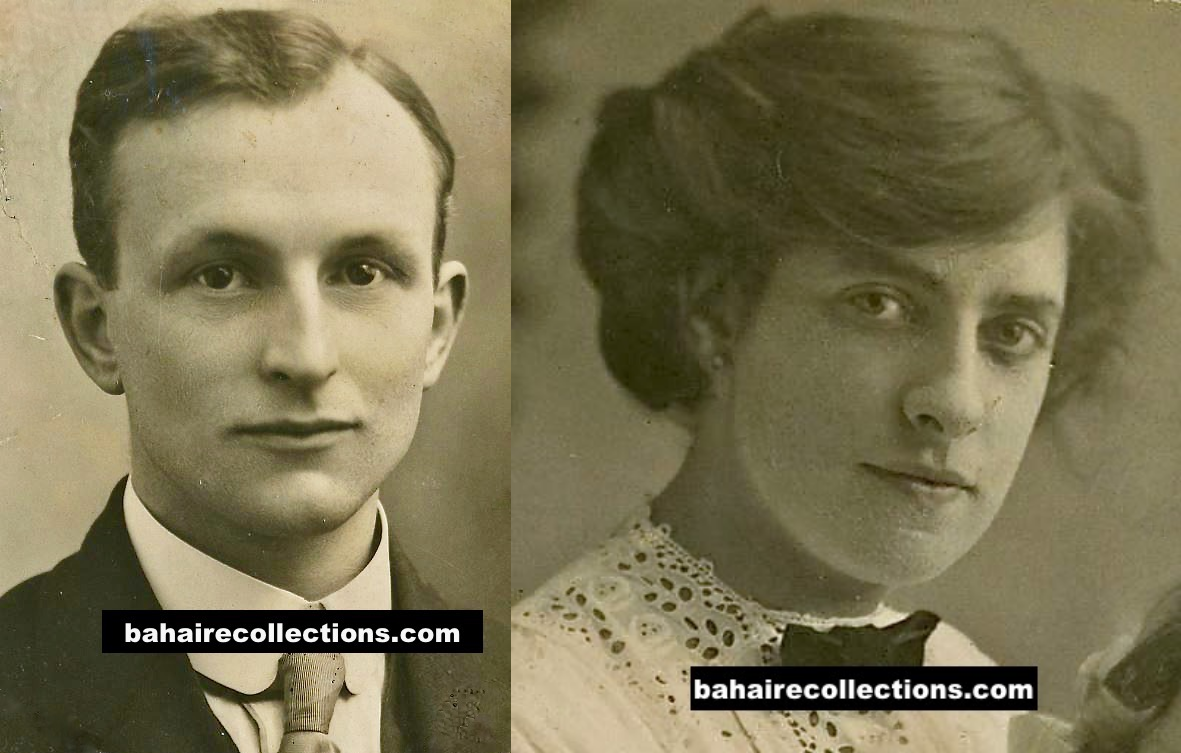
My grandparents Percy and Irene Hill
Shirley had a yearning that extended far beyond the confines of the family farm at Hoanga, near Dargaville in Northland, New Zealand.
MY MUM BECOMES A BAHÁ’Í
While working as a Primary School Teacher in several remote rural schools, my mum had studied various international movements that eventually led her to attend a talk on the Bahá’í Faith given by a US serviceman named Alvin Blum, in Auckland in the late 1940s or early 1950s. Her father Percy’s favourite book ‘God the Invisible King’ by George Orwell mentions the Bahá’í movement. But a chance meeting with an English gentleman, Basil Smith on the deck of a passenger liner leaving Auckland about 1952 put her thoughts about joining a ‘new religion’ on hold for 15 years. She married and brought up four nominally Catholic sons in the town of Whangarei in Northland New Zealand.
I was her second son, born on 11 February 1955. But all the while she was raising us as good Christians, she was nevertheless occasionally attending Bahá’í firesides with an elderly couple Beth and Jim Hancock
It was the death of Shirley’s staunchly Anglican mum, Irene, in 1970 that pushed her through the barrier of conventionality to follow her heart and declare as a believer in the Bahá’í Faith. Her phone call to the Hancocks expressing her wish to finally join the Faith in 1970 was a big surprise to Beth and Jim.
So naturally, her four sons had been growing up with quiet indoctrination in the principles of world citizenship, and not surprisingly, starting with myself in 1972, her sons one-by-one joined the same Faith and we four have each done our best to bring up the next generation of Smiths in accordance with the Faith’s exalted principles.
I distinctly remember my mum hosting an overnight stay during the visit of Bahá’í Counsellor Violet Hoenke to Whangarei perhaps about 1972, not realising that in a few years I would be meeting this intrepid woman again at her pioneering post of Papua New Guinea. ‘Sister Vi’ was officially the first Bahá’í to bravely pioneer to the Admiralty Islands and so earned the exalted title of the ‘Knight of Bahá’u’lláh’.
I BECAME A BAHÁ’Í
Having dutifully attended Catholic Mass most Sundays from childhood, I was upset at the age of 15 during the Catholic Doctrine Class after the mass one Sunday when I quizzed Father Faith, the youthful parish priest asking, ‘What will happen to those people in India who haven’t heard about Jesus?’. His reply did not resonate well as he responded, ‘According to our church they will not have a place in heaven’. I never attended that church again but felt free to explore other options which must have relieved my mother who had been secretly attending Bahá’í study groups for over a decade, encouraged by the Hancock family in Whangarei my hometown.
One boring Christmas holiday in December 1971 soon after I had obtained my driver’s license, mum asked if I would drive her up to the nearby town of Kaikohe where she would be attending a few sessions of the Bahá’í Summer School. Arriving there she suggested I come in with her rather than waiting for hours in the car. I was sitting at the back of a gathering of about a hundred people, as one of the dynamic American pioneers Bahá’í Mr. Ronald Pratt was suggesting that the Bahá’ís should be inviting people to join their wonderful Cause and not simply presenting the teachings. He asked the group if there was anyone here who were not Bahá’ís and I sheepishly raised my hand, at which he approached me, held my hand, and with a loving expression asked if I would like to join the Faith. I instinctively nodded and he embraced me saying, ‘Well now you are a Bahá’í” much to the surprised delight of my mother. This declaration by someone who knew virtually nothing about the Faith except that my mum had joined up so it must be fine – created a stir of excitement in the crowd and I believe my clumsy declaration may have triggered an unprecedented wave of enthusiastic ‘street teaching’.
True there was a loving atmosphere at that Summer School and after my declaration, I felt happy to swim in the school pool, for the first time being not acutely self-conscious of showing my skinny body in public. That bright sunny day was certainly a turning point in my life, and holding the little Bahá’í prayer book given to me by Mr. Pratt I began my exploration of the Bahá’í Revelation. Luckily there were some rather pretty Bahá’í lasses attending the local Bahá’í Feasts in Whangarei which incentivised my regular involvement with the community. And a growing group of vibrant young people and stalwart old believers there encouraged me to actually learn the basics of the Faith and delve into the scriptures of the Faith. I remember attending the annual Youth Conferences and feeling the joy of being a member of a world Faith that was moving fast in the receptive spirit of change that was felt worldwide during the decade of the 1970s.
I remember at about 18 years old as I was heading off to university, my mum handed me her old portable typewriter and said I must learn ‘touch typing’ as I would need it in future..(it was certainly good advice as I confidently type out these words- assisted by the Microsoft ‘autocorrect’ option!)
Though never a really competent typist, I was privileged to serve as the ‘Recording Secretary’ for the National Spiritual Assembly of the Bahá’ís of Papua New Guinea from about 2013 to 2020.
ANNUAL VISITS TO NEW ZEALAND
While my parents were alive, I felt it my duty to try to visit them annually if possible. A highlight would be taking our children out to ‘Ye Olde Barne’, the family beach house at Oakura Bay near the Bay of Islands in Northland New Zealand, a property that had been purchased by my father when he thought he would be an invalid after contracting tuberculosis at the time I was an infant. To this day my younger brother Justin still resides here and welcomes his very extended family to come fishing with him!

Basil and Shirley with three of their sons and numerous grandchildren about 1990. Justin is in front with the red shirt
PREPARING TO PIONEER
Marrying Tulua, daughter of William White of Samoa, was my biggest preparation for a long stint at pioneering. How did that happen?
I first met Tulua in Samoa in 1974 when the ‘Polynesian Committee’ on which I was serving, while studying architecture at Auckland University, suggested I fill a vacancy in a New Zealand Bahá’í Youth Visiting Team heading for Samoa. I remember that Karen Denton (later Karen Te’o) and Graham Hancock, Chuck and Anita Aranga, and Tan Giap Seng were among other NZ youths on that memorable trip.
Getting to know and befriending then the Auxiliary Board member William White in Samoa was a real pleasure, and later it would pay dividends when I sought five years later to obtain his consent for the hand of his daughter.
Tulua came to work in Auckland about 1975 and was on my ‘to visit’ list for the Polynesian Committee. We became friends and she helped type my university sub-thesis on the subject of designing a Bahá’í House of Worship for New Zealand. My design for the ‘Henderson Hyde Dunn Memorial Property’ House of Worship was based on the translucent fronds of the silver fern. It may not have been an exceptional design, but I was rather sad to learn that the only two copies of my sub-thesis typed by Tulua, were lost or discarded by both the National Spiritual Assembly of the Bahá’ís of New Zealand and the University of Auckland.
I achieved my Bachelor of Architecture degree. My non-Bahá’í professor coincidentally having submitted an unsuccessful entry in the design competition for the Panama House of Worship a few years before!
Tulua then returned to Samoa and phoned me once, asking if I was still interested in her, as she warned that there were lines of handsome Samoan men lining up, implying that I would lose my opportunity if I were to further procrastinate!
I had been working as an architectural graduate at the Property Division of the New Zealand Post Office HQ in Wellington for one year before saving up enough to travel to Samoa in early 1979 in time for the laying of the foundation stone of the Samoa House of Worship and a possible wedding. I had sent ahead with the Auxiliary Board member Gina Garcia, a simple red stone gold ring to confirm my engagement intentions to Tulua. That ring was a gift from my mother who had bought it in Shiraz in 1976 when I had accompanied her on pilgrimage in February 1976.
Tulua’s Bahá’í parents, my mother, and my ‘Catholic Dad’ thankfully gave their parental consents allowing the wedding to proceed.
I married Tulua the day after that auspicious and historical foundation stone event. My father was one of the witnesses to sign my marriage certificate – the other was none other than Hand of the Cause of God ‘Amatu’l-Bahá Rúhíyyih Khánum. I was told that when the beloved’Amatu’l-Bahá heard there was going to be a wedding at the Baha’i Centre in Apia, she requested an invitation, which was promptly and humbly delivered by William, my father-in-law to be!
RÚHÍYYIH KHÁNUM’S INFLUENCE
During my university days in Auckland from 1972-77, I had many times been the projectionist for the Bahá’í Club- showing the movie ‘Summer Breeze’ that features dynamic talks by Rúhíyyih Khánum during a Bahá’í Youth Conference at the Bahá’í House of Worship, Wilmette, USA. Her forceful addresses urged the youths to bravely follow the principles of Bahá’u’lláh and not the confused standards of the ‘flower power movement’ that was so strongly sweeping the western world.
Her book ‘Manual for Pioneers’ would have been on my shelf early in my youthful years and I have referred to it for guidance on later occasions.
Little did I imagine that this great lady’s signature would be affixed as a witness on my marriage certificate.
WHEN TO PIONEER?
During my years at university, I remember writing to the National Spiritual Assembly for their advice-whether to pioneer like so many of my contemporaries or to continue to complete my long five years degree in Architecture. They wisely counselled me that ‘the Bahá’í world will need architects’ and ‘you can pioneer later’. So I remember ‘home front pioneering’ to help form the Mt. Roskill Local Spiritual Assembly in Auckland about in 1976, then after graduating, moving to Wellington and helping establish the first Porirua Local Spiritual Assembly.
Tulua and I had been married nearly three years – with a 2-year-old son Zafar and 3-month-old daughter Penina, when our attempts to find a suitable pacific pioneering post with paid work came to fruition.
I had written letters of interest to Architects and Engineers in Tonga, Samoa, Fiji, and New Caledonia. Monsieur Vladimir Perm had replied from New Caledonia asking me to come at my expense for an interview. I took French night classes and had some encouragement from French Canadian Bahá’í couple living in Upper Hutt- then flew to New Caledonia where I nervously was interviewed ‘en francais’ by Monsieur Perm who offered me a job, helped me apply for a work permit and told me to return to New Zealand and wait for the date of my commencement- helping design a casino! He reckoned that in six months my French would be reasonable. Engineer in Apia also offered me a position but the salary was only a quarter of what I was earning in Wellington at that time, so I felt unable to accept it. Luckily, a firm contract offer came from the PNG Government before the casino funding was in place. I had to send a ‘regrets message to Monsieur Perm. The Papua New Guinea government had offered me a three-year contract and we arrived as pioneers in Papua New Guinea on 3 January 1978. Honestly, I had not done my homework and knew very little about the country that was about to become my home.
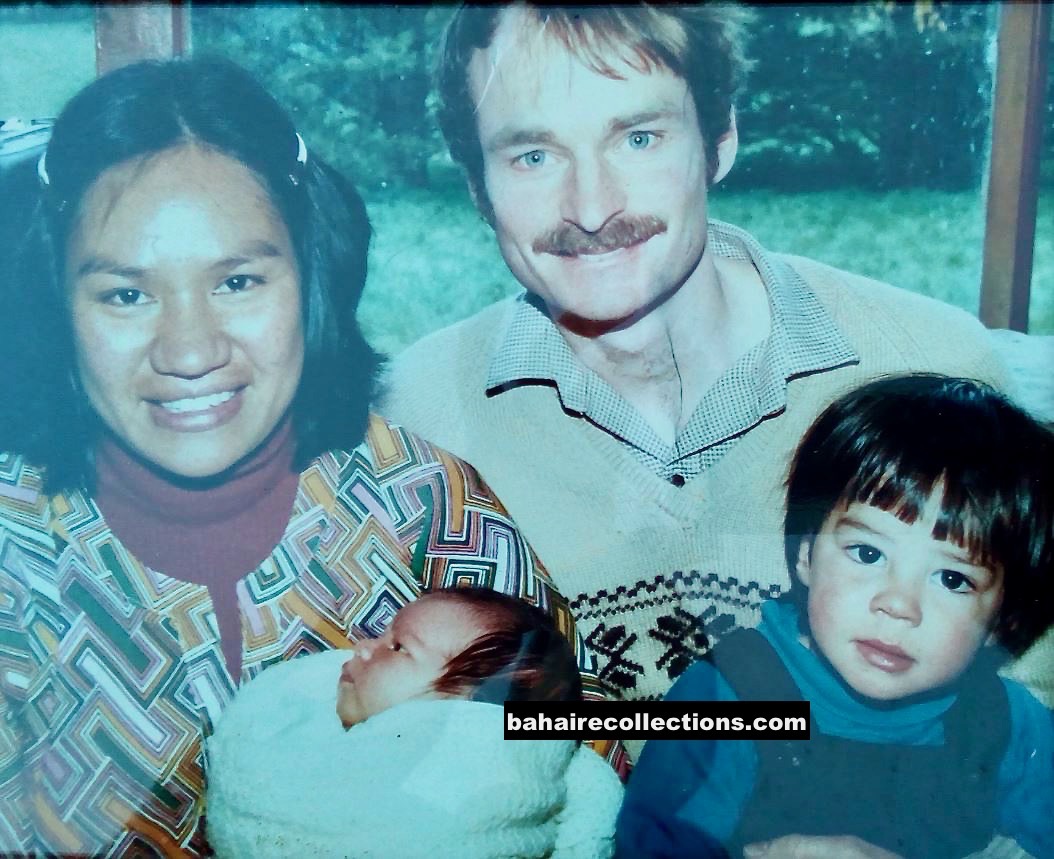 Derek and Tulua about to head to Papua New Guinea December 1982
Derek and Tulua about to head to Papua New Guinea December 1982
FELLOW PIONEERS IN PORT MORESBY
Soon after we arrived, we were warmly welcomed by ‘old pioneers’ N. S. S. Silan and Tahereh Nadarajah and their young family. They helped us settle into life in Port Moresby. We were also mentored by Diniar and Mehroo Mihrshahi and their teenage children. We were introduced to the Papua New Guinean believers who at that time were predominantly originating from Mt. Brown in Central Province. At that time the Bahá’í meetings were being held in various suburbs of Port Moresby which each had a Local Assembly.
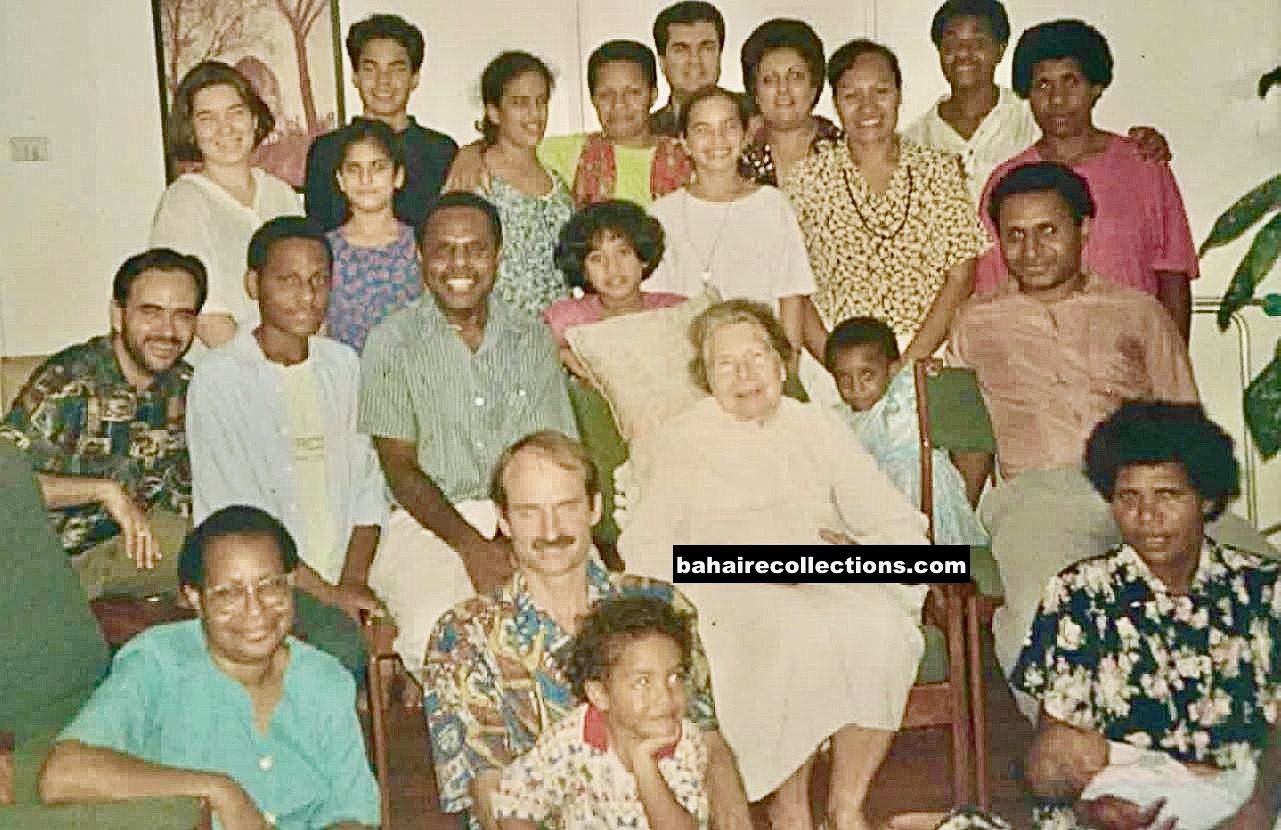
Port Moresby Baha’is with ‘Sister Vi’ (in white dress) circa 1993
We were fondly and enthusiastically told about ‘Doctor Naraqi’ who had previously been pioneering in Port Moresby but was currently in the USA to help his family obtain US citizenship. It was a joy about a year later when the Naraqis arrived back- the University Medical Faculty having held open an Internal Medicine Professor Position for a few years in the hope that he would be able to resume his lecturing position.
About the time when the Naraqi family returned, the Taeed Family moved from Lae to Port Moresby and Fuad and Gill Taeed together with many other pioneer families, families that were to make a big impact assisting the rapid development of the Faith in Papua New Guinea in the 1980s and 1990s.
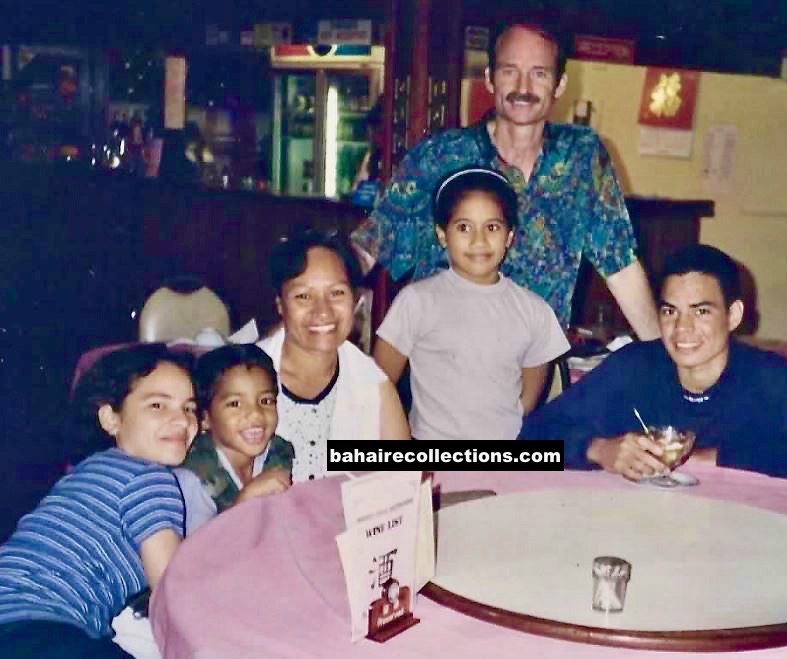
Family life in Port Moresby about 1994
RÚHÍYYIH KHÁNUM’S HISTORIC VISIT
In 1984, beloved Hand of the Cause of God ‘Amatu’l-Bahá Rúhíyyih Khánum spent some weeks visiting Papua New Guinea. Counsellor Dr. Naraqi often accompanied by Ramu Sannyasi, the dynamic Malaysian travel teacher, took this intrepid guest of honor to four places in Papua New Guinea, where she spent several days at each place – Mt. Brown, Gulf Province, New Ireland, and Highlands.
She also met with dignitaries in Port Moresby and her face appeared on the cover of the daily newspaper with the caption ‘Keep What is Yours!’. She encouraged the people of Papua New Guinea to keep their cultural identities and value them as they moved forward into a ‘modern world’.
I remember the privilege of sitting with her for an hour or so outside the Talair Terminal at Jacksons Airport. She was dressed in a smart red trouser suit and did not complain that there were no proper seats and she sat on the round log railings outside the terminal. I remember her words of advice – that ‘to deepen the newly declared Bahá’ís in the villages of Papua New Guinea could be summed up in two words – GO BACK!’ She said we simply needed to re-visit the new declarants and repeat to them the basic verities of the Bahá’í Faith that originally attracted them. Gradually, we would find ways to really strengthen their faith.
In hindsight, we failed to ‘go back’ to many areas and so lost many of those souls who had enthusiastically joined the Faith. But my guess is that probably half of the declarants in those ‘mushroom growth’ places remained firm in the Faith. The most significant of those is no doubt Daga- currently, the ‘flagship’ community where there are about 1000 ‘core activities’ occurring, making it a ‘frontier of learning’. Amazingly, I personally was not able to visit Daga until 2017! I had consciously put all my energy into strengthening the Central Province Bahá’í Communities in service to the Auxiliary Board from about 1985 to 2005.

July 1984, Rúhíyyih Khánum arrives back from Mt. Brown with a simple carved bamboo smoking pipe, the smell of which she said reminded her of her father!
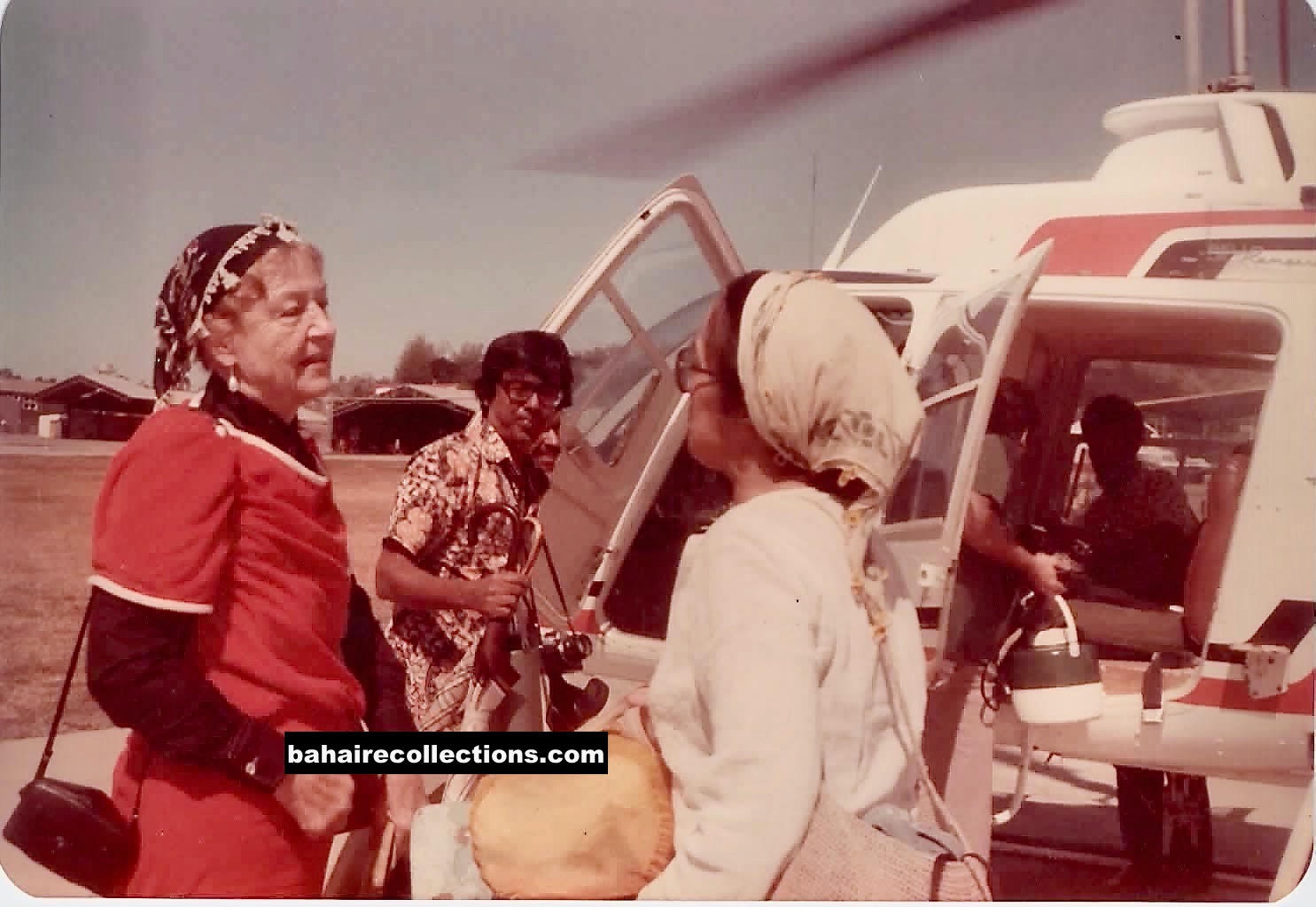
‘Amatu’l-Bahá, Silan Nadarajah and Violette Nakhjavani

Rúhíyyih Khánum being welcomed to the PNG Administrative College Hall by Sanomu Village Bahá’ís living in Port Moresby in 1984
SERVING ON THE AUXILIARY BOARD
Having served briefly on the Local Spiritual Assembly of Port Moresby, as Treasurer about 1984, I was appointed by Dr. Naraqi to serve on the Auxiliary Board as a Protection member for Central Province. While busy raising a family, there was a great feeling that we were all serving a much greater cause – taking the Faith of Bahá’u’lláh to the people of Papua New Guinea.
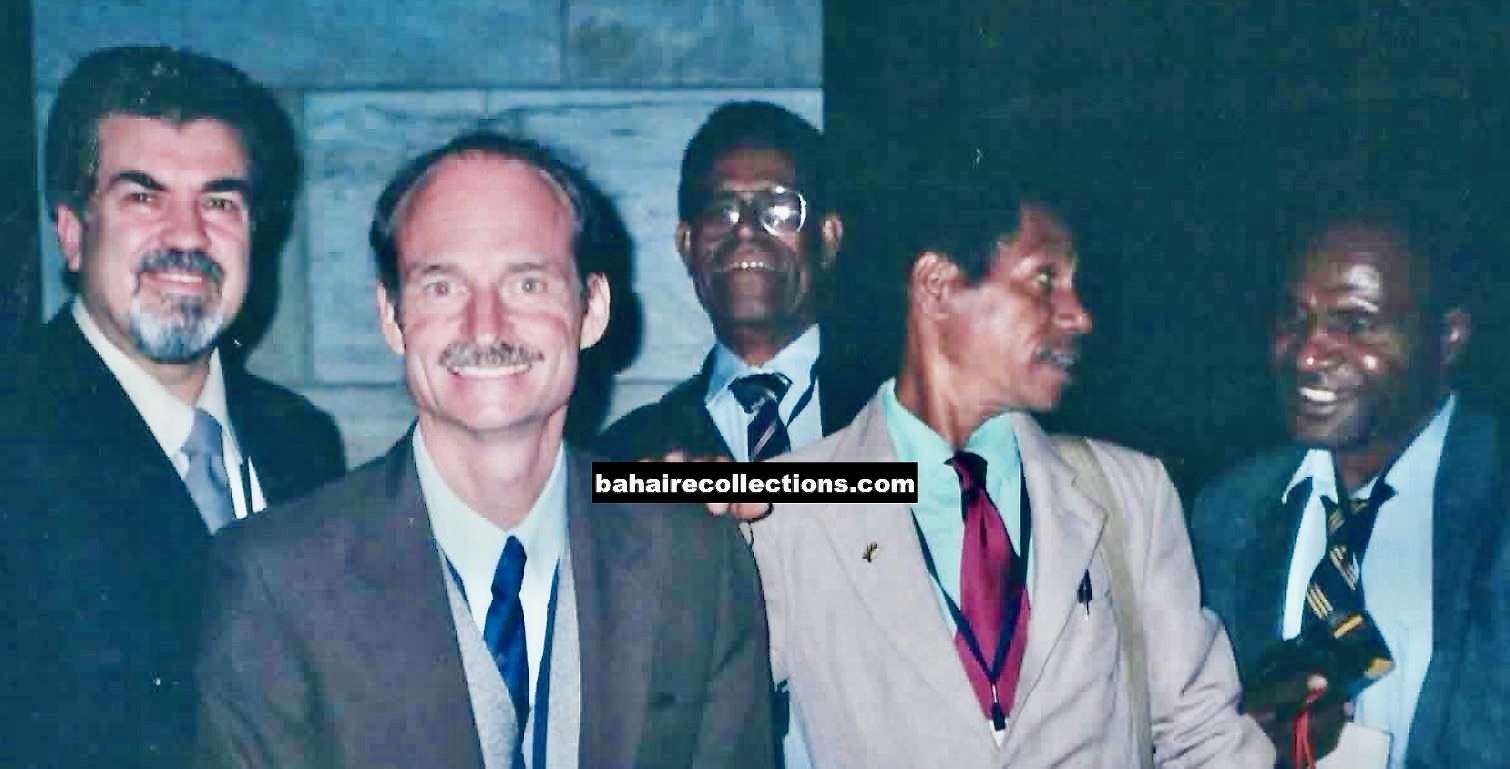
Counsellor Dr. Naraqi on left, with Derek, Vegua Heina, Iou Airo, and another PNG Auxiliary Board member in Haifa in 2001
Dr. Naraqi’s instructions were simple. Every Auxiliary Board member was expected to visit every one of the localities under his care at least once every year. As there were well over thirty Local Assemblies in my area of Central Province, I had to team up with Iou Airo, my fellow Auxiliary Board member for Propagation and together we would travel out as often as we could, to visit the Bahá’ís living all over Central Province.
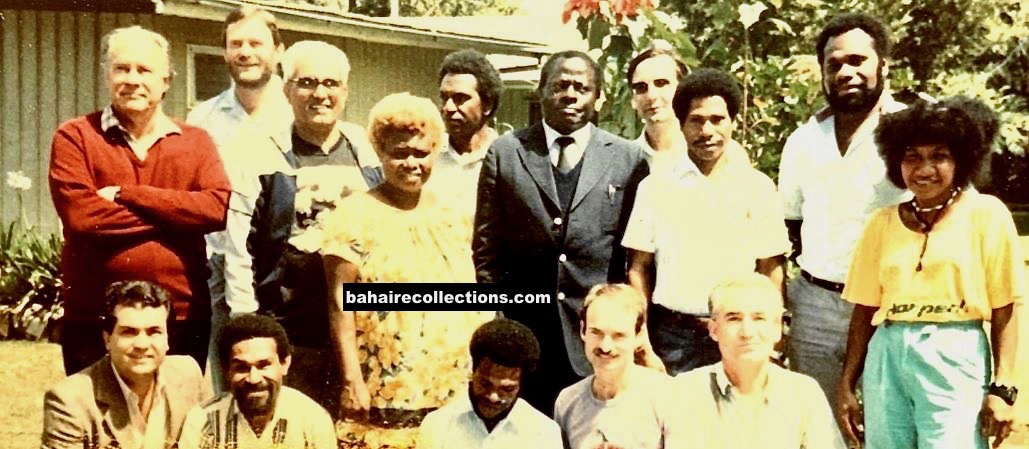
Annual Training of Auxiliary Board members in Goroka, circa 1990. Standing L-R: Noel Bluett, Roger Edwards, Habib Yaganegi, Roslyn Bale; D’Brani Isamu, Peter Vuiyyih (International Teaching Centre Member), Marc Vloebergs. Iou Airo, Michael Elias, Donna Syndo. Squatting L-R: Counsellor Dr. Naraqi, Vegua Heina, William Pandawa, Derek Smith, Rahim Milani
The Faith had made its biggest impact in Rigo mainly through the work of earlier pioneers in the 1970’s such as the Podgers – who had taught the Faith to the people of Mt. Brown in Rigo Inland, and the Mihrshahi’s who had concentrated on the Nego area of Rigo Central. Perhaps fifteen villages in Rigo were virtually all Bahá’ís, and perhaps another ten villages were predominantly Bahá’ís. How exciting to be able to try to accelerate the development of such villages where the people espoused a single faith! But I was soon to realise that espousing one’s faith was different from really living it through thick and thin!
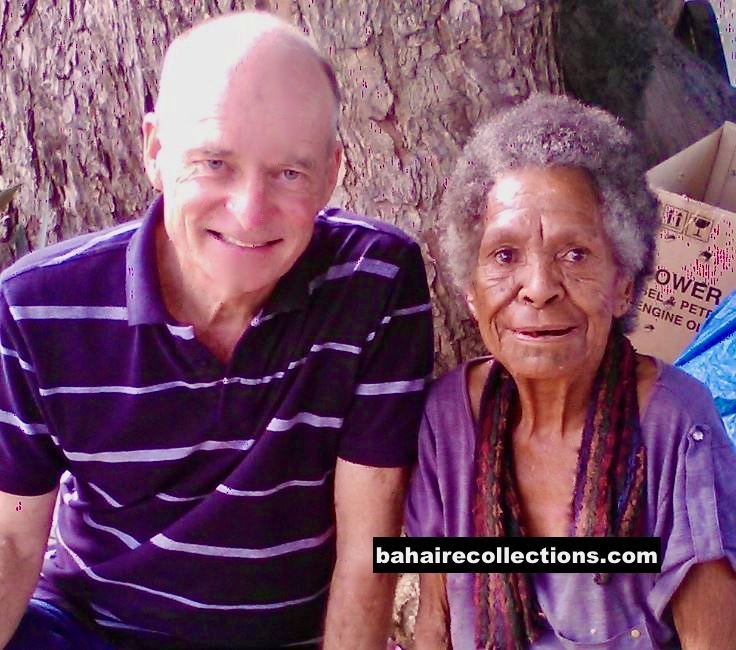
Derek Smith with Mrs. Ko’oi E’e, probably the first believer from Mt. Brown, who with her husband Saino Auma had been employed by Australian Pioneers David and Sue Podger at Sogeri during the 1970s. Here she is half a century later, still firm in her faith
We the Auxiliary Board members were not to take instructions from any other Bahá’í Institutions – but only from our Counsellor. There were instances in the past when due to misunderstandings of the separate spheres of work of the appointed and elected institutions, that Spiritual Assemblies would use the Auxiliary Board members as if they were their own agents to be sent out to handle any challenging task.
Counsellor Dr. Naraqi instructed his Auxiliary Board members to appoint a large proportion of female assistants, to build capacity and demonstrate that Bahá’u’lláh’s principle of equality was meant to be implemented! I perhaps took his instruction to the extreme, though my dear wife never ever mentioned it. Out of my 30 assistants, 25 were women!
This was not without the occasional male backlash. One memorable and rather a dramatic instance was when I appointed an illiterate woman with many children to be my assistant. Her husband was well educated and once served in public office for the Rigo Administration but was now secretly feeling jealous of his wife’s devoted services to the Faith. Once he called me over and scolded me for giving his wife grand ideas when he was supposed to be the boss of the family!
In another village, a man had stopped attending Bahá’í meetings and when I investigated the cause of his grievance, it was that his wife had ‘taken his place on the Local Spiritual Assembly’ during the recent annual elections.
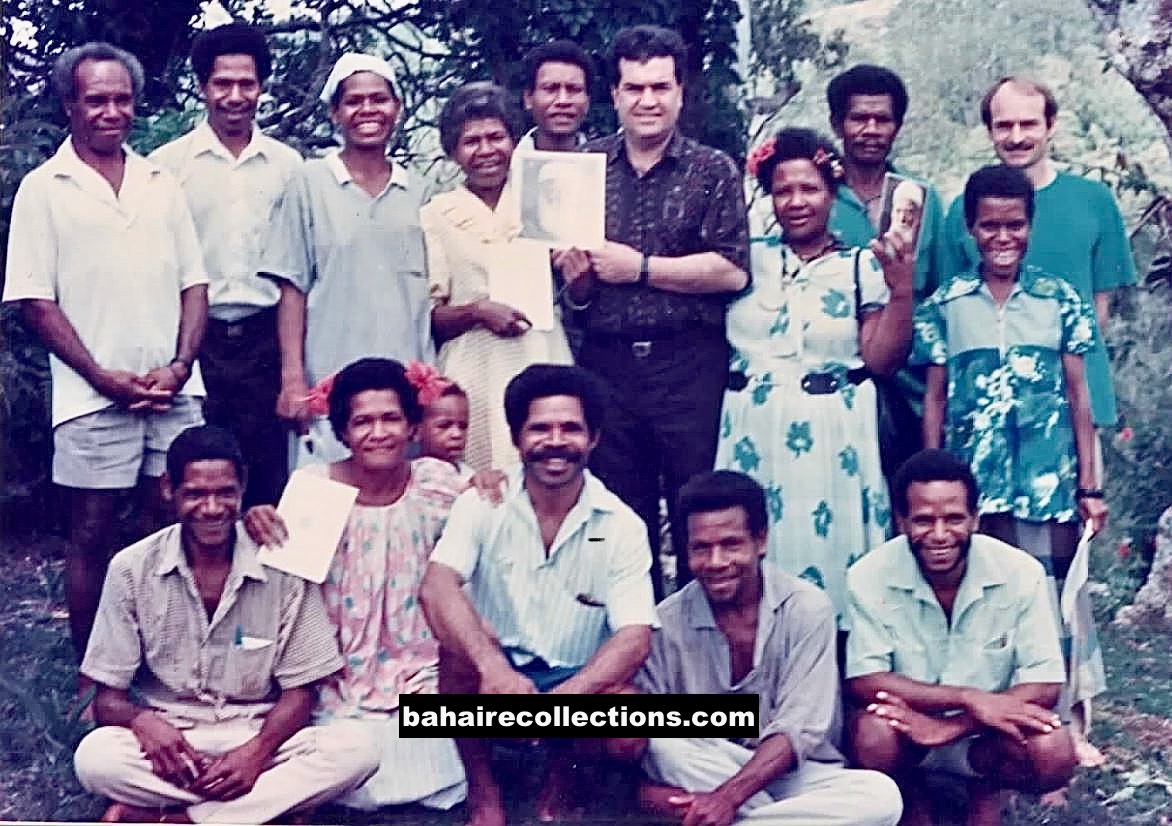
Sogeri Institute- Annual Assistant Training Weekends that would be visited by Counsellor Dr. Sirus Naraqi (here holding a photo of ‘Abdu’l-Bahá. The writer is on the far right back row
MEMORIES OF VILLAGE VISITS
I have not studied my old reports made to Counsellor Dr. Naraqi in setting down these notes. They are simply the stories that have remained in my memory and so deemed to be ‘memorable’ to me. Most Bahá’í men were proud of the achievements of their wives.

My assistant Mrs Aru Aihi and her loving and supportive husband Paul Koropo in Hisiu Village
DISTRIBUTION OF THE MOST HOLY BOOK
The National Assembly in 1992 had advised every Local Assembly that they would be provided one copy of the long-awaited ‘Bahá’í Bible’- the newly released Most Holy Book in English. Often it was the Auxiliary Board members who were privileged to deliver these copies. One memorable delivery was to Gegofi Village in Nego area of Rigo District, Central Province. The believers had decorated the track leading to their village for the distance of perhaps a kilometer before the village, using palm fronds and flowers. A welcoming party intercepted us about 200 meters from the village and literally carried us and the briefcase holding the precious Most Holy Book right into the village, where a colourful welcoming ceremony was held with joy and dignity. Such receptions were common throughout 1992 and 1993.
THE 1997 DROUGHT
My assistant at Cocoalands and who later served as an Auxiliary Board member was Alvin Ripuna. He was a tall, quiet, and dignified man, deeply devoted to the Faith. He was known to often not walk but run about twenty kilometers from Cocoalands to Moreguina on the rough gravel road, on bare feet, just to be on time to attend Bahá’í gatherings.
During the 1997 drought, I visited him and like many families, their gardens were finished and in desperation he was with his last ounce of energy, chopping down an old sago palm tree near his family house. It would be their meagre sustenance until the rains returned and gardens could provide at least some ‘greens’ to eat.
A sixteen-year-old Bahá’í girl from Sanomu Village died from eating a poisonous variety of wild yam when scavenging through the forest after her family gardens had dried up and were exhausted.
I managed to fly into Oram Airstrip and at Maruromu Village personally witnessed the rain forest blanketed in a haze of smoke, with the roots of the ancient trees tinder dry and smouldering – occasionally gusts of wind creating true flaring bush fires. Somehow the forests have been rejuvenated with the eventual return of normal seasonal rains.
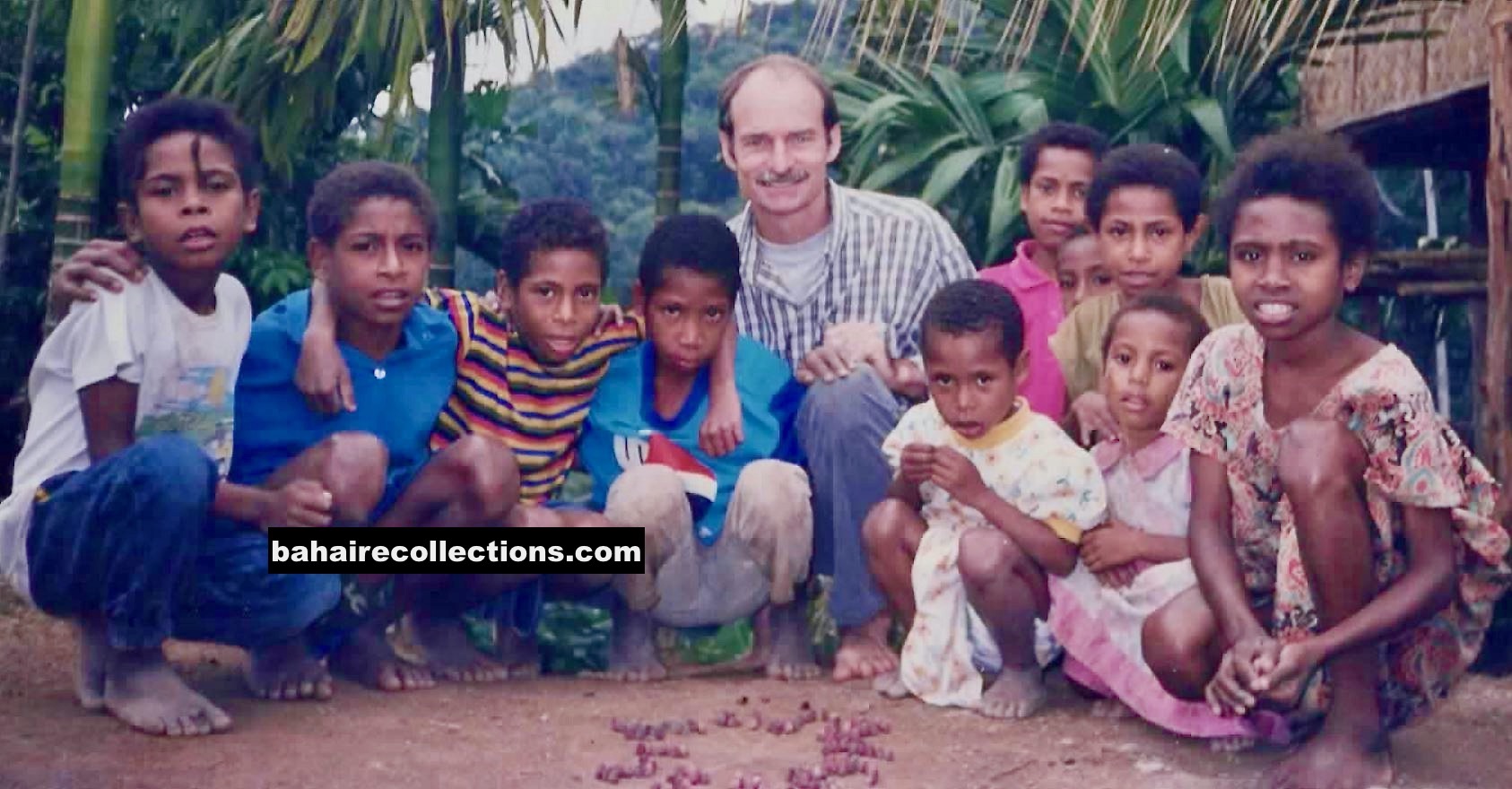
The joy of serving as an Auxiliary Board member
AGRICULTURE OR CASH CROPS?
Another ‘destruction of rain forest’ was caused by the eagerness of the Mt Brown Bahá’ís to see economic development. Rúhíyyih Khánum had encouraged the Mt Brown Bahá’ís to pursue their cash crops as initiated by David Podger in the early 1980s. About 1985, I visited Himaia Village where Inara Nevaru, one of the most devoted and energetic believers had chopped down at least two hectares of huge rainforest trees to plant his new garden of cardamom. Incredibly, when I walked out of those valleys and reached Karaikomana Village on a ridge about 25 kilometers away, looking back I could clearly see on the Himaia ridge-looking like a missing tooth, the gap in the rainforest canopy created by Inara’s axe! Sadly the price of cardamom dropped to the point where it was uneconomic to transport the crop out of Mt Brown.
And such dreams of ‘cash from crops’ were repeated about every decade since then, firstly with hot chilli peppers and later with coffee.
HOT CHILLIS
I personally witnessed the arrival of a chartered helicopter at Kunaia Village where the Baha’is had laboured for months to stockpile 18 tonnes of dried chilli stored in hessian bags in the rough store shed they had erected. When a government agriculture officer from Kwilika sauntered out of the helicopter he got a hot chilli welcome from the outstanding believer and one-time NSA member John Gapo. John confronted the public servant with loud and angry words to the effect that despite repeated requests from the villagers, not a single agriculture officer had ever bothered to get out of their comfortable offices to come on patrol and encourage the village people with their cash cropping. Only when the villagers from their own desperate and prolonged sweat had produced some viable crops, had that officer come for ‘free ride’ to survey the pickings!
I began to feel rather sorry for that public servant when the helicopter pilot announced that he would have to stay overnight with John Gapo as there was insufficient fuel to fly more than an empty chopper back to base. Naturally, John cooled down and regathered his composure, and the next day the agriculture officer escaped back to civilisation and his comfortable office at Kwikila Station.
AIRSTRIP AND RADIOS
About 1984 the Central Provincial Government set aside funds for an airstrip to be constructed by the villagers of Mt Brown. There were high hopes that this airstrip would transform village life for the better. Every village was allocated a chunk of the Oramu ridge to flatten, eventually creating an approximately 500-meter long airstrip, sloping steeply upwards at its northern end where a small turning space was created for light aircraft to park. A small, prefabricated building was helicoptered into the site to store about 50 wheelbarrows and spades, and other supplies to facilitate the hard manual operation. After about a year of back-breaking work, the airstrip was opened and for perhaps ten years there were more or less regular ‘service flights’ by various tiny airlines. It cost about K350 per person to fly one-way into Mt Brown.
Communication was always a problem, and I managed the airline operations by obtaining an old HF radio from one of the airlines. I had it repaired, purchased an aerial, and then physically lugged this radio together with a small new car battery, with the help of a couple of Bahá’í youths as my ‘carriers’ up to Mt Brown. After a twelve-hour slog, we reached the boys’ village and there was nobody willing to assist me to continue that evening. I doggedly continued on as night fell, with the heavy battery on my own back. Miraculously, I stayed on the right path by torchlight and reached another Bahá’í village in the middle of the night where I was totally exhausted, I stayed the night. The next morning I continued to Kunaia, where the radio was set up. Eventually, it was connected to a solar panel which kept the car battery charged.
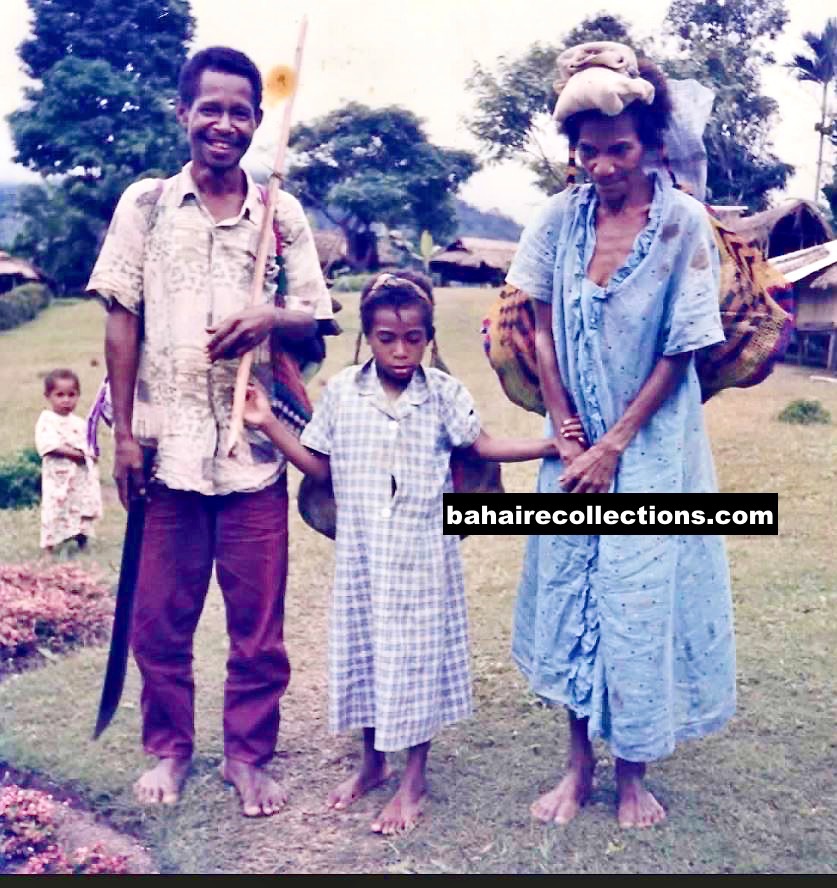
A Bahá’í family arrives in Kunaia, Mt Brown after a two days walk from Mt Maria
Sometime later, we were given a generous gift by the Australian High Commission – a state-of-the-art HF radio system including a base station installed at the Bahá’í National Office, together with a new outstation radio installed at Kunaia. It had a small solar panel. Another solar project that benefited the Bahá’ís was arranged by Cainus Homerang and John Volmer – who persuaded the Australian High Commission to install solar power systems in 500 villages, one of which happened to be Kunaia.
The National Assembly extended its network of HF radios to several of the remotest areas where Bahá’ís were concentrated. However, by the 2010s, with the arrival of mobile phone technology, coinciding with the growing challenges of repairing and replacing the aging HF system components, the National Assembly finally ceased the HF operation.
In 1992, I enjoyed taking my eldest son Zafar, then about 12 years old, into Mt Brown. We walked through the villages of Kunaia, Airiauka, Himaia, Waburaika, and Buredoburu and found a willing guide to take us a full day’s walk of about 20 kilometres westwards to a small hamlet where a Bahá’í family was living on a high ridge near Dorobisoro. This dear little family decided to name their first son Zafar. Tragically this child died and they had another child but that child also died. Tragically, such double deaths are common even to this day, due to lack of basic medical care and knowledge of primary health principles.
Before dawn the next morning we walked down a few kilometres to the Doribisoro ‘station’ where we caught another small plane flight back to Port Moresby.
By the year 2000, the cost of operating small aircraft increased, and only charter flights could be arranged at a significant cost.
Health, Sickness and Magic
Aid Post Orderlies were ‘barefoot doctors’ at the front lines of primary health care throughout Papua New Guinea. Sadly, over the decades the government failed to train and resource these public servants and the Bahá’í communities in remote areas suffered the consequences.
While Counsellor Dr. Sirus Naraqi remained as the Professor of Internal Medicine at the Port Moresby General Hospital, the village Bahá’ís would not only have special support for their ‘aid post orderlies’ but could also be assured of red-carpet specialist medical treatment of their illnesses were more serious. I remember several times taking barefoot villagers up the flights of stairs to Dr. Naraqi’s office, where they would be welcomed like VIPs. They would get the best medical treatment and most of the time would return fully recovered to their villages.
Sadly with the departure of the Dr. Naraqi family from PNG in the early 2000s, the situation of the village Bahá’ís rapidly deteriorated. I remember one instance visiting Mt Brown and finding that the Aid Post Orderly himself was ill with malaria and had no medicine at all! Luckily I was able to give him the required doses from my own first aid kit. Sadly that good servant of the people died a few years later of tuberculosis.
Then followed a spate of deaths from tuberculosis and tragically in some villages, the people began to blame witchcraft for these deaths.
FINDING LAND WITH A ‘NATIONAL PRESENCE’
In the 1980s the Universal House of Justice agreed to the relocation of the National Office from Lae to Port Moresby. While Lae had been logistically more central since the National Assembly was formed in 1979, it was obviously Port Moresby, the Capital City where the Faith should eventually have its ‘national presence’.
However, advice from the Universal House of Justice was that the land where the Hohola Local Bahá’í Centre was situated adjoining a residential area was not suitable for a ‘national presence’ and encouraged by Counsellor Dr. Naraqi and with the energetic Ramu Sannyasi as the National Secretary, a serious effort was made to identify land in the capital.
Temporarily the ‘national office’ was housed first in a tiny ground-floor spare room in the entry area of a residence owned by Dr. Jalal Mills in Angau Drive Boroko. Then as the number of staff gradually grew, and one room was no longer sufficient the office moved to what would later become my Tusitala Architects Office at Section 11, Lot 1 of Boroko Drive. With the encouragement of Counsellor Dr. Naraqi we upgraded the dilapidated out-building, added on a large deck and for perhaps two or three years the National Office operated from this humble location until about 1997 some more befitting buildings were constructed at the current National property in Waigani.
ETHNIC CONFERENCE CENTRE SITE
Counsellor Dr. Naraqi had suggested that by couching our land applications as being for ‘An Ethnic Conference Centre’ rather than as a Bahá’í Headquarters we might have more success in our applications. We all agreed that calling our project an ‘Ethnic Conference Centre’ was preferable to describing as the National Bahá’í Office. Professor Rahim Milani – strategically positioned as Head of the Faculty of Architecture and Building, provided some image sketches prepared under his direction by his senior students.
Ramu and I made frequent visits to the National Physical Planning Office, meeting the senior officers and identifying what vacant government land might be applied for by the Faith.
I remember preparing under the close guidance of the Counsellor and Professor Rahim Milani at the University of Technology, various architectural concept drawings for several vacant sites, and in some cases these were formally submitted for Physical Planning Office’s approval.
One such scheme was right in front of the National Parliament House on what is known as ‘Independence Park’ and I remember submitting to the Town Planner for Port Moresby a perspective concept drawing of a circular conference centre with a ‘boulevard’ beside it on the axis of the National Parliament House. Some years later this boulevard appeared in the Waigani City Centre Plan. I fondly imagine that my sharing of the ‘boulevard concept’ with the Senior Physical Planner helped to secure this feature into the subsequent update of the Waigani City Centre Plan. Interestingly, where my drawing had indicated a circular ‘Ethnic Conference Centre’, the Chinese Government funded an ‘International Conference Centre’ and built it about 2016. But it was oval in plan, not circular.
The National Spiritual Assembly was determined to obtain befitting land and an opportunity to meet the Minister of Lands culminated in him allowing the Bahá’ís a temporary license over vacant Portion 1998 in Waigani Drive. We heard that a Malaysian Developer had previously been given such a license to build a huge commercial development, but this had failed to eventuate and so the land was again available. Neither we nor that Minister of Lands knew that this land had been ‘promised for the Catholic Cathedral by the previous Minister of Lands’.
THE CATHOLIC LAND
Thrilled to have the temporary license as a prelude to acquiring formal title, the Bahá’ís obtained a Fence Building Permit began in earnest to proceed with earthworks and fencing on Portion 1998. Ramu Sannyasi, the Secretary rented a house only a few hundred metres from the property. From there he supervised a dynamic civil engineering contractor named Captain Fred whose graders, excavators and trucks constructed driveways around the property and re-contoured the land along Waigani Drive to prepare for fencing. Well-drillers successfully put in an expensive water bore about the midpoint of the Waigani Drive boundary.
Welders fabricated hundreds of steel spike fencing panels in Ramu’s front yard, and these panels were just starting to be erected along Waigani Drive when the Catholic Archbishop personally marched up to the site demanded that the work stop as he had been given this land by the previous Minister of Lands.
It happened that the Pope was about to visit PNG and the Catholics who represented about a quarter of the entire population of PNG, were wanting His Holiness to bless this land for the proposed new Catholic Cathedral. The senior public servants in the Department of Lands were all Catholics so it was a miracle that the Bahá’ís had got thus far.
With a Stop Work Notice resulted from the Archbishop’s visit, and the National Assembly appealed to the new Minister of Lands, the previous Minister having recently resigned due to ill-health.
Noting that the Bahá’ís had spent a considerable sum improving the land, the Minister decided to slice Portion 1998 into two equal parts – to be known as Portion 2352 to the north-west and Portion 2353 to the south-east. The former was higher and rockier than the latter. In the mediation that followed, Ramu noted that the Minister had asked the Catholics which half they preferred and they responded saying they liked the higher side and Ramu replied quickly that he had no objection. The Catholic team then deliberated and said they had just changed their preference and now wanted the flatter portion. Again Ramu said the Bahá’ís would accept that decision. And so that is how we obtained the present House of Worship site and ‘lost the other half’ to the Catholics. Subsequently, the Catholics failed to make a formal application for their half, and the land still remains vacant. We pray that somehow in the future this vacant land could be added to the House of Worship property.

Sir Juius Chan, a renowned national leader opens the first National Office for the Bahá’í Faith in Port Moresby
THE VITAL ROLE OF MY WIFE TULUA
Writing these memories I must declare that it is my valiant wife Tulua who has really made my own humble services possible. She served the Faith for decades as a member of the National Spiritual Assembly of Papua New Guinea and concurrently managed to raise our lovely family. I hope she will record her own stories but I take the liberty of inserting a few photographs indicating a glimpse of her services of frequently being included in official delegations of the National Assembly and also volunteering to go to the remotest villages to support the work of the Faith.
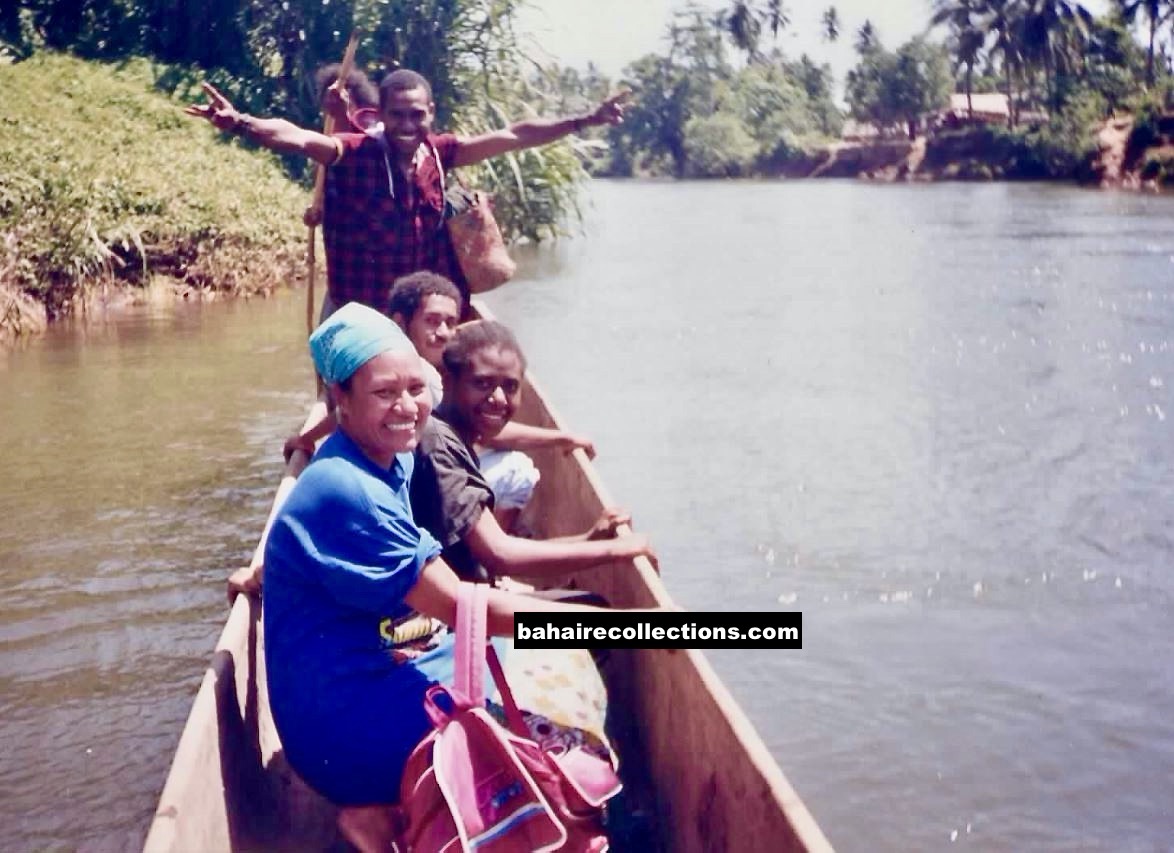
Tulua crossing the river at Ukaukana Village, Kairuku Central Province about 2010
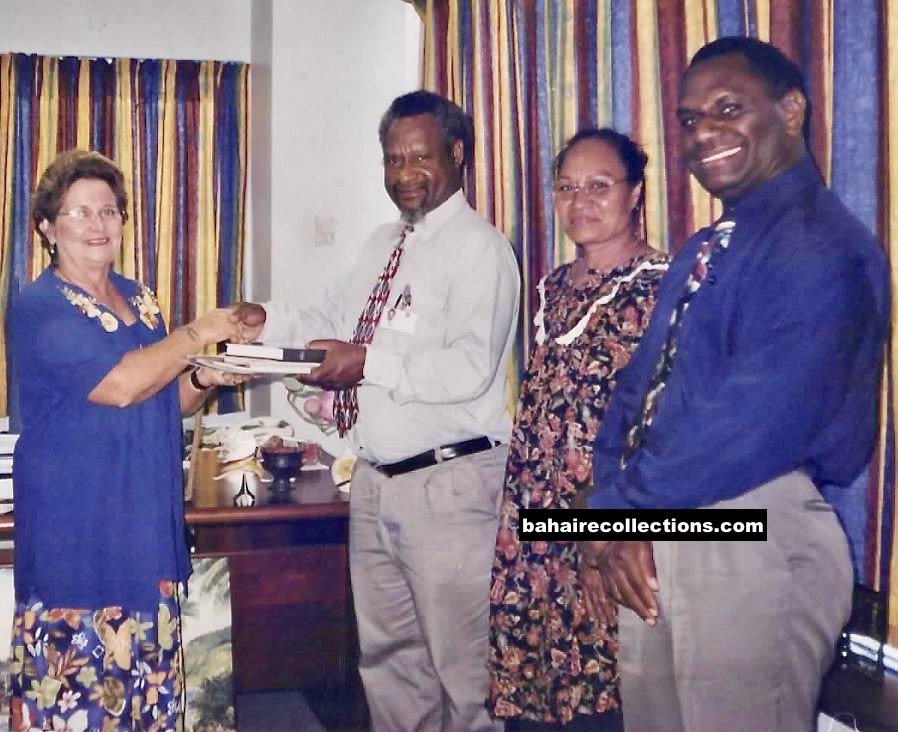
Dame Carol Kidu a Senior government minister receiving a delegation from the National Assembly comprised of Erama Ugaia, Tulua Smith, and Paul Lupai circa, 2000
SERVING THE PNG INSTITUTE OF ARCHITECTS
As soon as I settled in PNG I was happy to support the PNG Institute of Architects and served in various capacities on the executive committee and a term as president in the early 2000s. In these services, I was usually mentored and accompanied by Professor Rahim Milani who was a fellow Bahá’í pioneer. His wife Marsha served the National Assembly for decades.
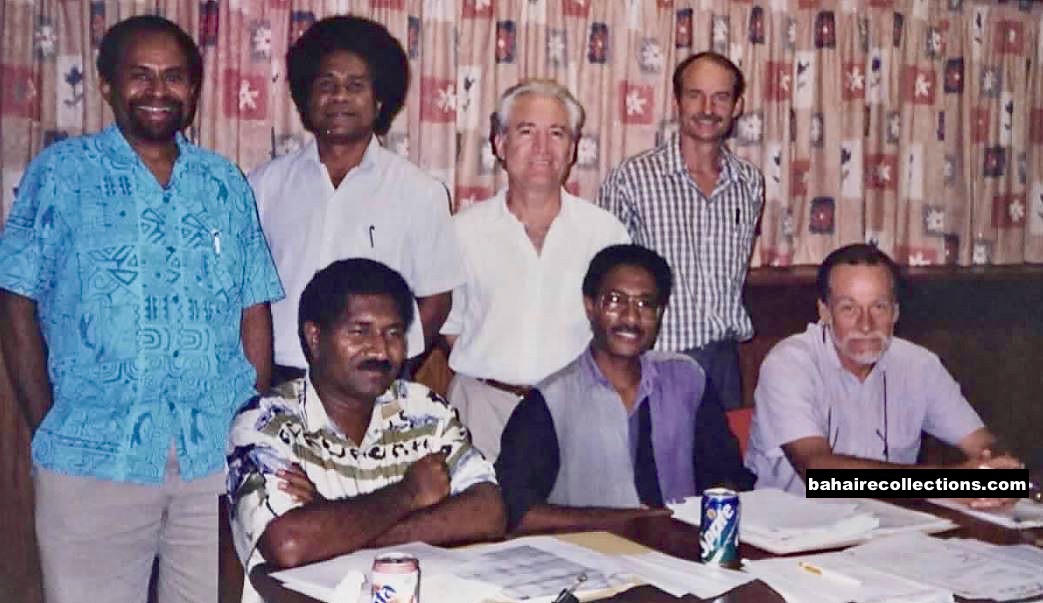 PNG Institute of Architects, circa 1990. Standing L-R: John Andrew, Laua Rovagaua, Prof Rahim Milani. Derek Smith. Seated L-R: Dr. Andrew Sariman; Alan Karo, David Gole (who had recruited me from NZ in 1983)
PNG Institute of Architects, circa 1990. Standing L-R: John Andrew, Laua Rovagaua, Prof Rahim Milani. Derek Smith. Seated L-R: Dr. Andrew Sariman; Alan Karo, David Gole (who had recruited me from NZ in 1983)
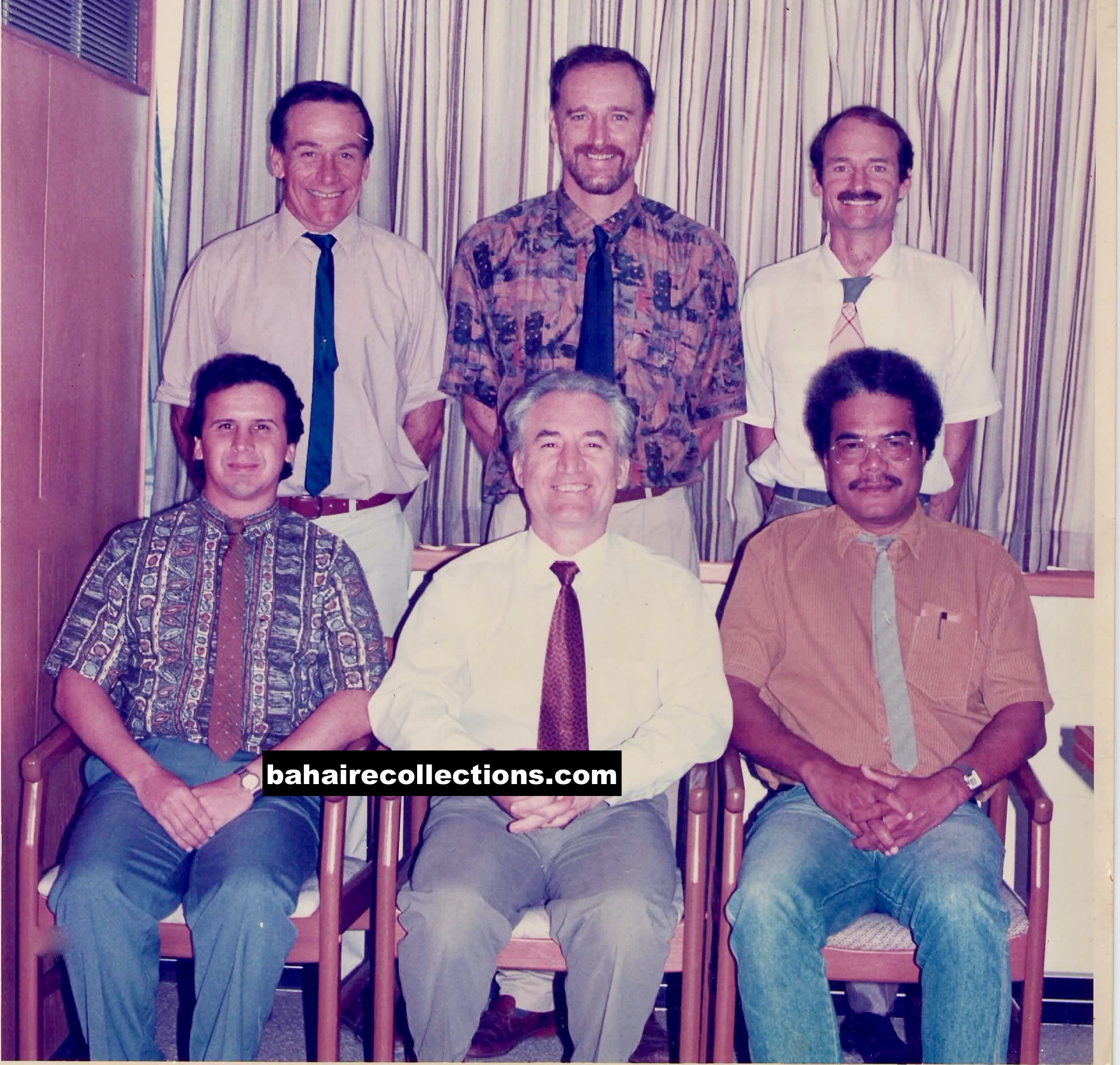
The inaugural PNG Board of Architects 1992. Standing: L-R: David Gole, Clifton Bancroft, Derek Smith. Seated L-R: Greg Rudani, Prof. Rahim Milani, Ali Bou
Some years later in 2008, I was very surprised to be awarded an ‘M.B.E’ award from Her Majesty the Queen with the citation ‘for services to architecture and the building industry’.
THE TWIN HOLY BIRTHDAYS – BICENTENNIAL CELEBRATIONS 2017-2019

Hisiu Village Bahá’ís, west of Port Moresby 2017. Standing on left of the banner is Mrs. Aru Aihi, the first Bahá’í of Hisiu, previously my assistant to the Auxiliary Board.
SOME MEMORABLE INDIVIDUALS
There are many dear friends in my mind as I write this but here are a couple of those. Mr. Asisi Kinaina, early believer from Mt Brown. Illiterate and humble but stubbornly proclaiming the Faith he would take Bahá’í pamphlets to the market and ask people to read them to him! He probably brought more souls to the Faith than we who have enjoyed the privilege of going to school and university! Asisi died just before I left PNG in 2019.
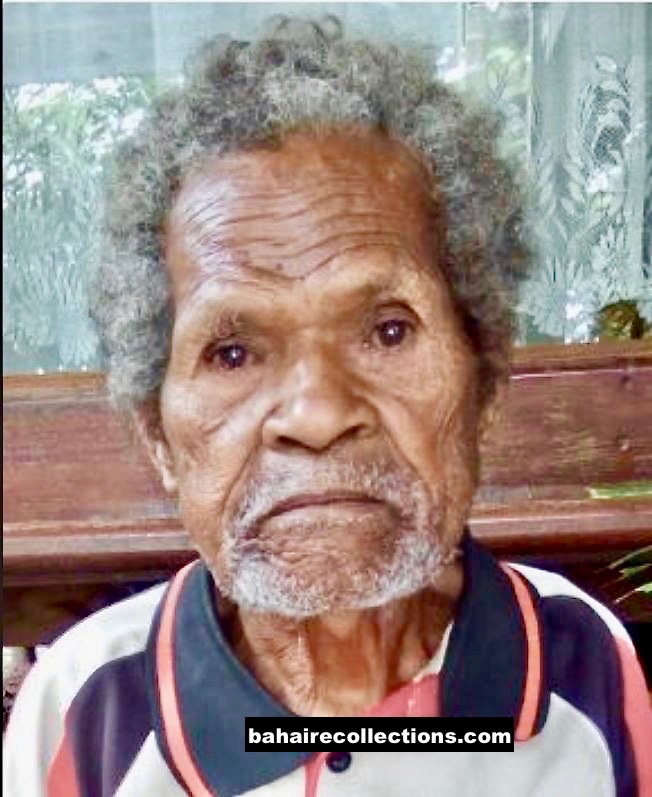
Mr. Asisi Kinaina
Miwa Enaenae from Poroi Village, Gulf Province- Living in Rabia Camp Port Moresby since the 1970s. Miwa was one of the first Papuan believers.
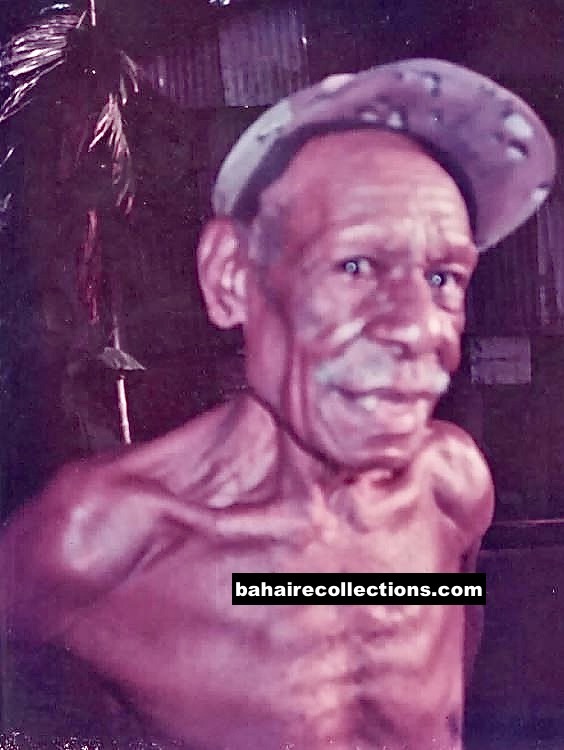
Miwa Enaenae
The author looks forward to the next chapter of his services to the Cause he loves.
Derek Smith
New Zealand
31 January 2021
ABOUT THE AUTHOR
Derek Edward Smith was born in 1955 and brought up in New Zealand. He embraced the Bahá’í Faith while a teenager, completed his architecture studies, married a Samoan Bahá’í and they pioneered to Papua New Guinea in 1983. Having bought up a family of four there, he recently returned to New Zealand to enjoy a crop of lovely grandchildren.
Copyright@bahairecollections.com